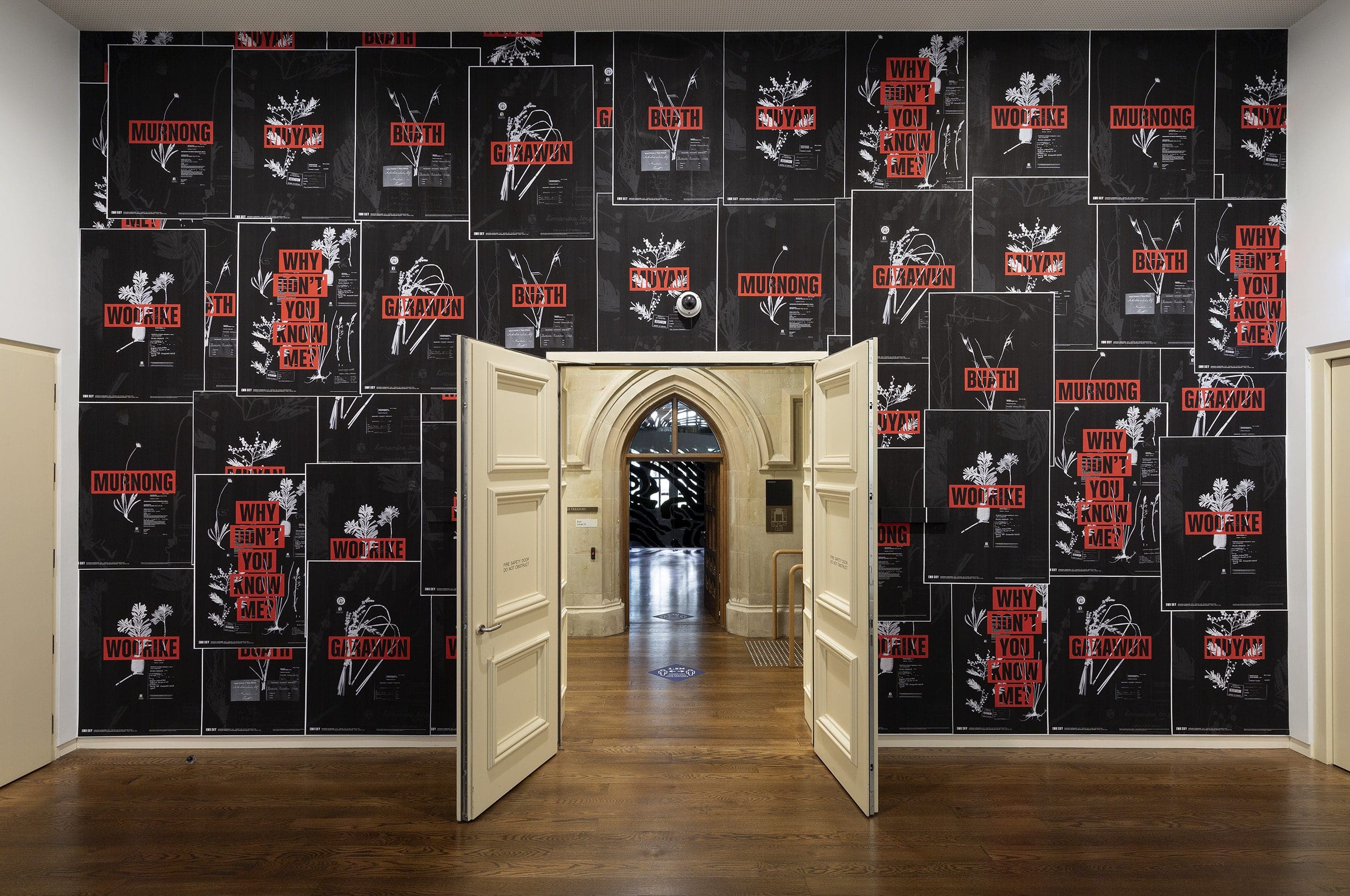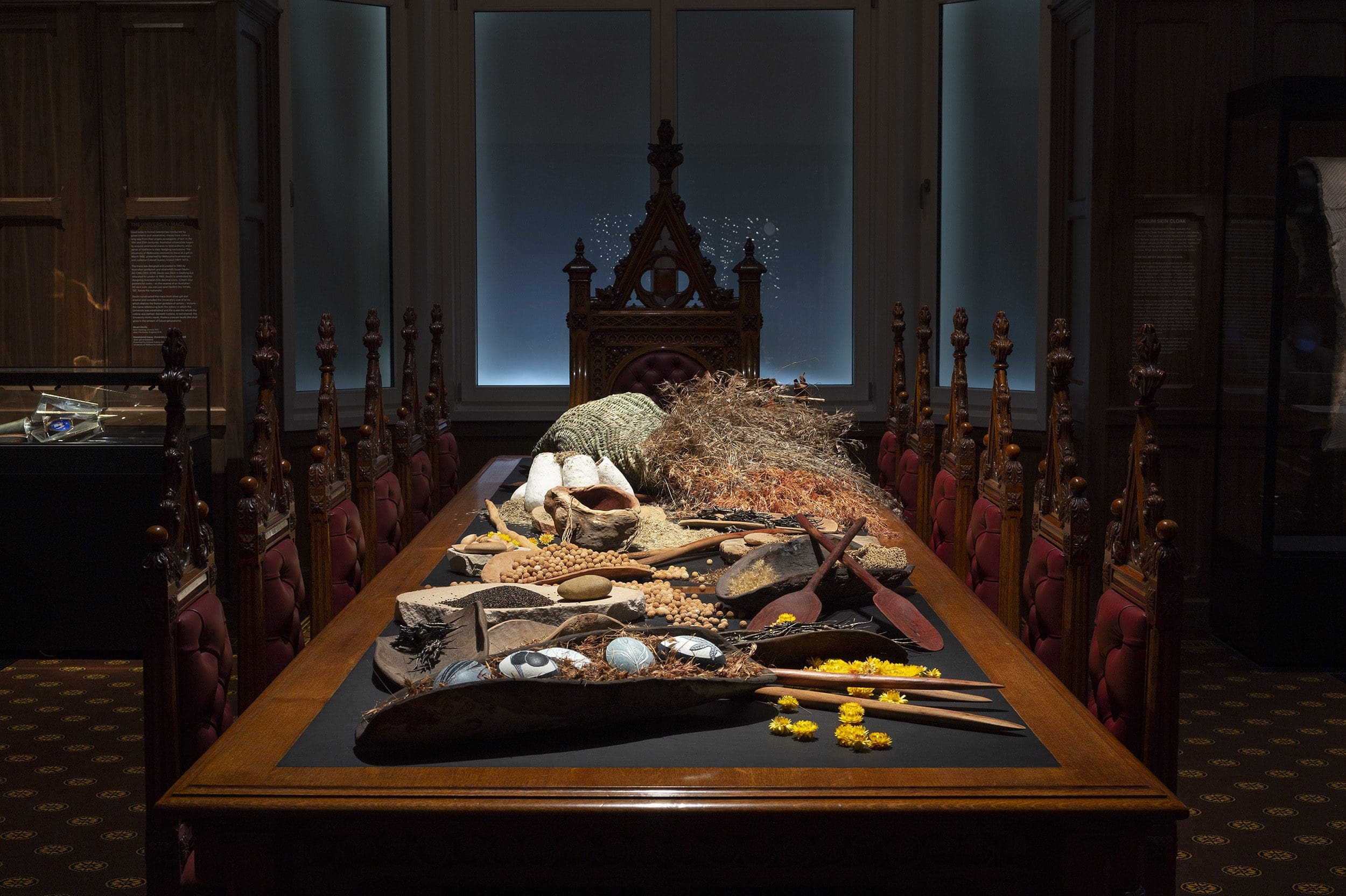
Piercing the veil
A new exhibition at Buxton Contemporary finds a rich complexity in the shadowy terrain between life and death.
Emu Sky invites audiences to listen and to reflect on the importance of respecting, resourcing and valuing Indigenous communities and their knowledge of Country. This vast exhibition explores past, present and future narratives related to science, innovation, plant use, land management, and the agricultural practices of Australia’s First Peoples.
Zena Cumpston, a Barkandji woman and Emu Sky’s curator, explains how “Everything you see in this exhibition comes as a result of the foregrounding of relationships above all else.” This emphasis on connection is demonstrated with contributions by more than 30 Aboriginal community members across south-eastern Australia. With artworks spanning from installation and sculpture to film and linocuts—storytelling is the focal point of sharing such crucial ways of sustaining Country. Here are four featured artworks, and the significance behind them.

Emu Sky Language Posters, 2021: Aboriginal people across Australia have developed a multitude of uses for plants through scientific observation and testing over the longest time imaginable. Plant knowledge has been central to the longevity of Aboriginal communities, who use plants for medicine, nutrition and technologies, such as watercraft, tools and traps.
Brooke Wandin, a Wurundjeri woman and Woiwurrung language speaker and educator, provided the Woiwurrung language overlaid on these plant specimens from the University of Melbourne Herbarium collection, in collaboration with Madeline Critchley, Jax Plumley and Zena Cumpston.
Each of these plants are from Wurundjeri Country and are an important part of Wurundjeri culture. Language is a powerful repository of cultural knowledge and knowledge of Country, and language reinvigoration and revival is vital to the survival and continuance of identity, relationship to Country and the health and wellbeing of Aboriginal communities and Country.

untitled walam-wunga.galang, 2019-2021: Uncle Stan Grant Snr speaks in his Wiradjuri language, vocalising a silenced story of the traditional ways of his people. Uncle Stan reminds us that we must listen to our Elders and respect the knowledge they hold, working together to return Country to health and abundance.
“nindi-nhi bagaray-bang nguram-bang maying-galang-girri-gu—we want healthy Country for future generations.”
Australia’s 350+ diverse Indigenous languages encode our relationship to Country and complex cultural knowledge. Our languages are central to our wellbeing and identity, and while Indigenous languages have greatly suffered as a result of colonisation, many Indigenous communities across Australia are working to protect and reinvigorate their mother tongue.

Emu Sky, 2008: Emu Sky is one of a large body of linocut works made over many years by Uncle Badger Bates to illuminate and share the cultural stories of his Barkandji Country.
The ‘emu in the sky’, which acts as a map for living across many diverse Indigenous groups across Australia, is not known through looking at ‘the stars’ but is instead formed by a dark space, and can be understood only from the holistic Indigenous perspective of ‘looking at the sky’, not just the stars. Much of our complex knowledge as Indigenous peoples may be seen to sit within these ‘dark spaces’ that the western lens has been unable to recognise. The architecture of perception—what people have been overwhelmingly taught, has not allowed for the illumination that comes with the acceptance of and respect for other ways of seeing.

marrum (overflowing), 2021: A collaboration between several Aboriginal artists, marrum (overflowing) continues the stories told in Wiradjuri/Kamilaroi artist Jonathan Jones’s recent ground-breaking exhibition Bunha-bunhanga: Aboriginal agriculture in the south-east.
As Jonathan explains: “The Wiradjuri word, bunha-bunhanga, meaning ‘the abundance of food’, is used to describe the Country that south-east Aboriginal communities created—bountiful Country that has now been degraded by the introduction of western farming techniques and government mismanagement. In 1925 the Wiradjuri Elder and leader John Noble, also known as ‘Marvellous’, lamented that his once bountiful Country was a thing of the past. Noble, like many other survivors of the frontier, bore witness to unimaginable change. He would have known the old ways when Aboriginal people weren’t living on crumbs but enjoyed an abundance—an abundance of food and an abundance of resources, from which our communities drew strength. Yet Country wasn’t a passive provider for wandering ‘hunter-gatherers’. Country rich in possums, fish and yams doesn’t happen by accident or by chance. It was achieved with precise knowledge and through generations of conditioning which ultimately resulted in the world’s oldest living cultures.”
The works in marrum (overflowing) speak not only to past abundance, but also attest the rich knowledge still alive in these artists and their communities, continuing to make cultural items celebrating the bounty of Country, just as the Old People did.
Emu Sky
Old Quad, The University of Melbourne
Until 21 August
The above artwork descriptions have been republished from Emu Sky.